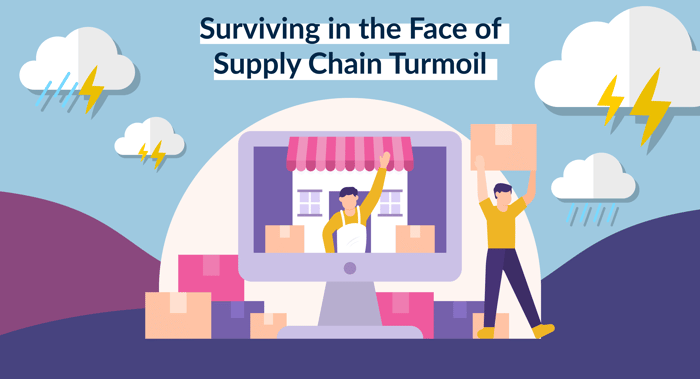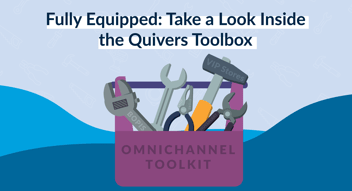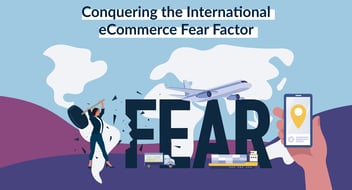CEO CORNER: Surviving in the Face of Supply Chain Turmoil

The beginning of 2020 sure feels like a long time ago. Since then, the supply chain has taken a beating: From pandemic-induced factory shut-downs in China to collateral damage from Russia’s invasion of Ukraine. That’s not to mention the sensational scenes of a quarter-mile-long container ship getting stuck in the Suez Canal, plus the unnerving energy of retailers unsure whether they’re going to be under or overstocked tomorrow. The sheer extent of turmoil might lead you to believe we’re tumbling toward an all-out supply chain apocalypse.
The thing is, even before the pandemic ushered in this period of supply chain chaos, interruptions were not unheard of — companies could expect to experience a 1-2 month supply chain disruption every 3 and a half years. While lean supply chains and a just-in-time approach to inventory are often profitable, they leave you with little resilience in the face of disruptions.
So, how do you safeguard yourself against both “typical” and unprecedented disturbances? You remain calm, remind yourself that predictions of apocalypse are built on emotion and not logic, and do what you can to build resilience in your commerce ecosystem.
Building Supply Chain Resilience
In recent months there have been more problems related to overstocking than shortages, but that doesn’t mean we’ve seen the last of manufacturing and shipping delays. Over the next decade, companies may face disruptions that erase half a year’s profits or more. One single prolonged shock to production, such as another pandemic or war, could wipe out 30-50% of one year’s earnings, and that’s before you even consider interest, taxes, and depreciation.
We have to accept that disruption is inevitable, but we shouldn’t be nihilistic. On the contrary, there are strategic decisions you can make today that will minimize the impact of future disruptions — and help you prosper in spite of them.
Source More Locally
It’s time to re-evaluate just-in-time inventory strategies. While suppliers in China may be cheaper, sourcing locally or regionally allows for more control over inventory and moves the product closer to the end consumer.
Lately, this approach has gained popularity to the extent that it has a host of different names including onshoring, reshoring, homeshoring, nearshoring, and domestic sourcing. While diversifying the supplier base is an effective way to ensure supply chain resilience, it’s important to recognize that it often incurs significant costs.
Harness the Full Power of Data
In today’s complex procurement landscape, it’s essential for businesses to leverage real-time analytics and decision-support tools. The enriched data sets attained through these means provide a better understanding of the procurement process and help you make more informed decisions related to consumer needs, production schedules, logistics, and delivery management.
With real-time visibility into product, inventory, and shipping data, you can enable fast fulfillment for your consumers as inventory becomes available, no matter where it’s located. This means you can make operations more nimble even in the event of a disrupted supply chain. What’s more, pre-orders and ATS (Available to Sell) ordering can help you anticipate demand and adjust warehouse orders accordingly, leading to more efficient operations.
With effective technology tools and enriched data sets, you can respond quickly to market shifts and challenges, making informed decisions that enhance your procurement processes and improve customer satisfaction.
Put the Consumer First
This data can also be leveraged to improve communication and give consumers updates and important information in real-time, which helps to reduce frustration in the event of delays.
Tailoring a consumer’s shopping experience based on their individual preferences, behaviors, and past interactions with a brand is often referred to as personalization. As a strategy, personalization is very effective: it makes 91% of consumers more likely to shop with brands and helps 80% of companies boost their revenue. Still, only with the right data can brands anticipate consumer needs, offer a great personalized experience, and plan inventory accordingly.
The importance of a consumer-focused approach is perhaps no better exemplified than in two companies' responses to the recession of 2008–2009. While Company A was forced to close some of its stores, it took the opportunity to increase its investment in the stores that stayed open, thus reinforcing its focus on its core customer segment. On the contrary, Company B ventured into a segment outside its traditional area of expertise during the recession. It should come as no surprise that Company A emerged from the downturn in a far stronger position than its competitor, establishing a solid foundation for significant growth in the subsequent years.
Omnichannel Inventory Management
Increasing buffer stock capacity is a straightforward and effective way to build inventory resilience. However, not all brands have the capacity to do this since producing and storing excess safety stock can be prohibitively expensive.
That’s why an omnichannel approach to commerce that forges key strategic allegiances between brands and retailers is often the best way for both parties to strengthen inventory positions.
When a brand and its retail network agree to fulfill for one another, they gain access to each other's inventory. In the event of a brand running out of stock of a crucial product, it can still convert on its website while leveraging one of its partnering retailers to fulfill from their own inventory. This approach not only reduces the average order-to-delivery time, but also enhances overall customer satisfaction.
Likewise, when a retailer doesn’t have stock, the brand can dropship the item. The retailer is then able to provide a convenient local pickup option, which boosts foot traffic and allows them to cross-sell and offer additional services such as customization and setup.
The world of commerce is never simple and situations can vary from region to region. Let's say the snow is amazing in the Rocky Mountains but awful in the Northeast of the US. Retailers near the Rocky’s will quickly sell out of ski equipment, while those in the Northeast will have plenty of inventory left because no one needs it. That means a consumer near the Rocky’s can still order from the brand as a retailer in the Northeast will be able to fulfill. This illustrates how forging a greater connection with retail partners can effectively optimize supply and demand.
How to Respond to Four Different Inventory Scenarios
With all this talk of a supply chain apocalypse, you’d be forgiven for thinking I’m going to jump into talk of the four horsemen. Instead, I’m going to tell you how to respond to different inventory scenarios — without losing your head.
1. All Out Armageddon
When neither your brand warehouse nor retail network has any stock, the best way to put out fires is to put pre-orders to work.
It's important to streamline your inventory management process to ensure that orders are fulfilled on a first-come, first-served basis — regardless of where the shipments arrive. Don’t panic, but make sure your fulfillment system is flexible enough to optimize inventory immediately.
2. Relying on Retailers
If you have limited stock in your warehouse but your retail partners hold decent inventory levels, there’s a simple solution.
Leveraging your retail network with omnichannel delivery methods like Ship-from-Store and BOPIS (Buy Online, Pick Up In-Store) will help you avoid out-of-stock notices and increase inventory turnover and sell-through.
3. A Mixed Bag
If you’re holding decent inventory levels but some of your retailers are struggling to maintain stock, you can use fulfillment options like Ship-to-Store to dropship quickly and meet regional demand for your products.
With these systems in place, you’ll be able to power local, in-store fulfillment experiences that go beyond your retailers’ individual stocking positions.
4. Great Shape
If your brand and retail network both have strong inventory positions, you may feel inclined to take a moment to relax. That’s why it’s important to remember that regardless of your current position, demand for products and further supply chain disruptions can be hard to predict.
Be proactive and take advantage of these moments to fully optimize your inventory. Make sure you’re completely in sync with your retail network and have access to all the necessary data to make informed stocking decisions. Listen to consumers and configure your omnichannel fulfillment options including Ship-from-Store, Ship-to-Store, BOPIS, and White Glove Delivery. Remember that providing consumers with what they want is key to building resilience — satisfied shoppers are far less likely to switch to a different brand during any future supply chain disruptions.
Omnichannel Resilience
If the last few years have taught us anything, it’s that it’s not always possible to prevent supply chain disruption. What is possible, and perhaps even essential, is for specialty brands to adopt a consumer-first approach that utilizes technology to reinforce connections with retailers and ensure maximum resilience against future disruptions.
The Quivers Omnichannel Toolkit gives you full control over your commerce systems and ensures compatibility with other popular platforms including Lightspeed, Shopify, Quickbooks, Rain, and Counterpoint.
With Quivers, you can protect yourself against supply chain disruption by streamlining the exchange of valuable real-time information with your retail partners and syncing your brand's inventory with that of your retailers. Quivers’ unique approach to commerce allows you to offer in-demand fulfillment options like BOPIS, Curbside Pickup, Ship-from-Store, and White Glove Delivery, even when you’re out of stock.
It’s the end of the commerce world as we know it, but for all the right reasons. Now, no matter what disruptions rear their head, specialty brands and retailers have the tools to not just survive, but to thrive.



